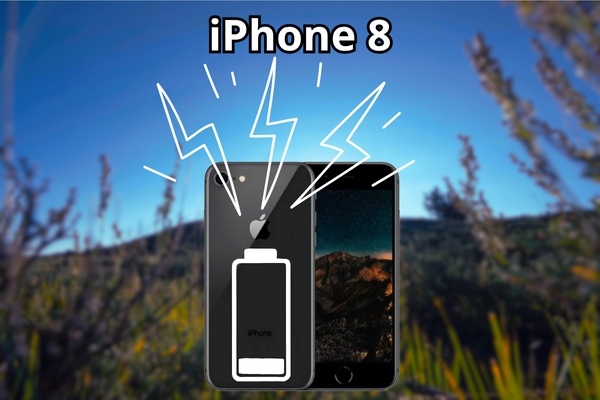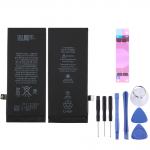Why does my iPhone 8 run out of battery so quickly?
Publicado por MariaWhy does my iPhone 8 run out of battery so quickly? ?
Is your trusty iPhone 8 no longer keeping up like it used to? ? If you notice that the iPhone 8 Battery drains faster than lightning, you're not alone. This is one of the most common concerns for users of this model. At iLevante.com, we understand your frustration and are here to help you understand why this happens and, more importantly, how you can breathe new life into your device!
The iPhone 8, launched back in the day with impressive features, has proven to be a robust companion. However, like any piece of technology, hardware wears out, and the battery is undoubtedly the component that suffers the most over time and use. Let?s dive into the heart of this issue and explore the solutions that will allow you to continue enjoying your iPhone 8 to the fullest.
The iPhone 8 Battery: Get to Know It Inside Out ?
To understand why your iPhone 8 might be running out of power, we first need to understand its "heart": the battery. The iPhone 8 uses a lithium polymer-ion (Li-Po) battery.
Technical specifications of the iPhone 8 battery:
- Type: Lithium Polymer (Li-Po).
- Voltage: 3.82V.
- Original capacity: 1821 mAh.
- Compatible references (iPhone 8 Models): A1863, A1905, A1906.
- Battery part numbers: 616-00361, 616-00357, 616-00358.
- Price: 9.50€
When your iPhone 8 was new, with a battery in perfect condition, you could expect considerable duration. For instance, in intensive usage tests, such as continuous internet browsing via 4G, a factory-fresh iPhone 8 could offer you about 9 hours and 54 minutes of autonomy. With more moderate use, this duration was significantly extended, allowing you to get through the day without worries. However, over time, this capacity diminishes.
Why does my battery degrade so quickly? ?
Battery degradation is a natural process, but certain factors can accelerate it, causing your iPhone 8 to run out of battery in no time:
- Chemical aging: This is the main cause. Lithium-ion batteries lose capacity with each charge and discharge cycle, as well as simply over time, regardless of usage.
- Charging habits: Frequently charging the phone from 0% to 100%, or keeping it constantly connected to the charger once it has reached 100%, can affect long-term health.
- Exposure to extreme temperatures: Both excessive heat (leaving the phone in the sun, in the car) and extreme cold can damage the internal chemistry of the battery.
- Intensive software use: Background applications, constant location services, very high screen brightness, or even buggy iOS updates can consume a lot of power.
- Low signal environments: When your iPhone 8 is constantly searching for a mobile signal in low-coverage areas, the modem works harder and therefore consumes more battery.
- Hardware issues: Although less common, a faulty charging port, a damaged cable, or even a problem in the logic board can cause unusual battery drain.
How to know if your iPhone 8 battery is faulty? ?
There are several signs, both software and physical, that will indicate that your iPhone 8 battery needs replacement:
Software Diagnosis:
The first place you should go is the "Battery Health" section in your iPhone settings:
- Go to Settings ??.
- Tap on Battery.
- Select Battery Health & Charging.
Here you will see the Maximum Capacity percentage. If this percentage is below 80%, Apple recommends considering a replacement. Additionally, if you see the message "Service", it is a clear indication that the battery is significantly degraded, and its performance is affected.
Physical and Performance Signs:
- Fast drainage: The most obvious sign. The battery drops from 100% to 20% in a few hours with minimal use.
- Unexpected shutdowns: The phone shuts down suddenly, even with a considerable battery percentage (e.g., 30% or 40%).
- Slow performance: The iPhone 8 feels slower than usual. This is because iOS reduces processor performance to avoid unexpected shutdowns when the battery is degraded.
- Overheating: The device overheats excessively, especially during charging or intensive use.
- Battery swelling: This is a critical sign! If you notice the screen of your iPhone 8 lifting or the chassis bulging, it is very likely that the battery is swollen. This represents a risk and must be replaced immediately by a professional.
Types of Batteries (in general) ?
Although your iPhone 8 uses a Lithium Polymer battery, it is interesting to know the different types of battery technologies that exist in the market:
- Lithium-ion (Li-ion)
- Nickel-metal hydride (NiMH)
- Lithium Polymer (Li-Po)
- Nickel-cadmium (NiCd)
- Lead-acid battery
- Zinc-carbon batteries
- Alkaline batteries
- Zinc-air cells
- Silver oxide batteries
Changing the iPhone 8 Battery: Quick Guide and Necessary Tools ??
Changing the battery of your iPhone 8 is a medium-difficulty repair that, with the right tools and patience, you can carry out. At iLevante.com, you?ll find the high-quality parts and components you need.
Essential Tools:
For this repair, you will need a specific tool kit:
- Pentalobe Screwdriver (P2): For the two screws at the bottom of the iPhone.
- Phillips Screwdriver (PH00): For the internal screws holding the protective plate.
- Plastic opening tool (Spudger): Ideal for disconnecting cables and lifting components without damage.
- Plastic opening picks or tools: To slide around the screen and break the adhesive.
- Suction cup: To lift the screen from the phone?s chassis.
- Precision tweezers: Useful for handling small connectors and removing adhesive residues.
- Adhesive strips for battery: Necessary to securely attach the new battery.
- Heat gun or hair dryer (optional): Helps soften the screen and battery adhesive.
Basic steps for battery replacement (Summary):
- Turn off your iPhone 8: Essential for your safety and the device?s!
- Remove the Pentalobe screws: The two screws at the bottom, next to the charging port.
- Open the screen: Use the suction cup on the bottom front of the screen and, with a plastic opening tool, slide gently to separate the screen from the chassis. Be careful with the connection cables on the right side (when looking at the phone front-facing).
- Disconnect the battery: Once the screen is open, locate the battery connector. Remove the protective plate (with Phillips screws) and disconnect the flex cable with the plastic tool.
- Remove the old battery: The battery is fixed with adhesive strips underneath. Pull them carefully to detach them. If they don?t come off, you can apply some heat gently on the back of the phone to soften the adhesive, but with great caution.
- Install the new battery: Place the new adhesive strips on the back of the new battery and fix it in its position.
- Reconnect and close: Connect the new battery flex cable, reattach the protective plate, and screw it in. Reconnect the screen and close it, ensuring it fits well along all edges.
- Reinsert the Pentalobe screws: And you're done!
While these are the basic steps, we highly recommend looking for a detailed visual guide (video tutorial) before starting the repair to see the process in real time.
Common problems and how to prevent them during the replacement:
- Damage to flex cables: The cables connecting the screen and battery to the logic board are very delicate. Always use plastic tools and disconnect the cables by lifting them straight up, not pulling them.
- Broken screen when opening: Apply force evenly with the suction cup and opening tools. Do not force it if the screen does not separate easily; gentle heat can help.
- Swollen battery: If the old battery is swollen, handle it with extreme care. Never puncture, bend, or apply excessive force to it. Remove it gently.
- Leaving fingerprints or dirt: Avoid touching connectors or the camera lens with your fingers. Use tweezers if necessary.
- Not using the right tools: Attempting the repair with incorrect tools can damage screws and internal components.
The iPhone 8 Speaker: Details and Common Problems ?
The iPhone 8 features stereo speakers, one integrated into the upper earpiece and another at the bottom of the device. This configuration provides an immersive audio experience for calls, music, and videos.
Common speaker problems and possible solutions:
-
Low or no volume:
- Ensure the silent/ring switch on the side is not activated.
- Check volume settings in "Settings > Sounds and vibrations".
- Restart the device.
- Turn off Bluetooth to ensure the audio is not being sent to another device.
-
Distorted sound or "crackling":
- It could be a sign of dirt or dust accumulated in the speaker grille. Gently clean it with a soft, dry-bristled brush.
- Sometimes it?s a software issue. Try an iOS update or reset settings (without erasing data).
- Defective microphone (in calls): If you are heard poorly, the problem could be with the microphone, not the speaker. Try different apps (voice recorder, video calls) to isolate the problem.
- Hardware issues with the speaker: If the previous steps don?t work, the speaker might be physically damaged and require replacement. This usually happens due to drops, liquid exposure, or severe dirt buildup.
Other Common Hardware Repairs in iPhone 8 ?
In addition to the battery and speaker, there are other components of the iPhone 8 that often require attention over time:
-
Screen Issues:
- Symptoms: Cracked or broken screen, colored lines, black spots, unresponsive screen, defective backlight, or completely black screen.
- Basic solution: Most screen issues, especially physical ones, require the complete replacement of the screen module (digitizer + LCD/OLED). If the issue is minor and the screen isn?t broken, check internal connections if you feel comfortable opening the device.
-
Charging Problems (Lightning Port):
- Symptoms: The iPhone does not charge, charges very slowly, the cable easily disconnects from the port, or the phone is not recognized by a computer.
- Basic solution: First, inspect the Lightning port for lint, dust, or accumulated dirt. You can clean it with a wooden or plastic toothpick (never metal) very carefully. If cleaning doesn?t work and the issue persists with multiple cables and chargers, the charging port is likely damaged and needs replacement.
-
Camera Problems (Rear or Front):
- Symptoms: The camera app shows a black screen, photos are blurry, the flash doesn?t work, or the camera doesn?t focus.
- Basic solution: Sometimes these issues are software-related. Try restarting the app, closing all background apps, or even restoring iPhone settings (without erasing data). If the issue persists, check that the lens is not dirty or physically damaged. If the damage is internal or software-related, you may need a camera module replacement.
Give your iPhone 8 a new life with iLevante.com! ?
We hope this article has provided you with a clear insight into why your iPhone 8 battery might be failing and what to do about it. At iLevante.com, we are committed to offering you high-quality iPhone 8 spare parts, including iPhone 8 batteries, iPhone 8 screens, speakers, and all the iPhone 8 components you might need. Our goal is to equip you with the information and components to repair your iPhone 8 and extend its lifespan. Don?t let a drained battery stop your day! Explore our catalog and reclaim the performance you love from your iPhone 8.
Ready to give your iPhone 8 a new lease on life? Visit our website and find the perfect replacement!









